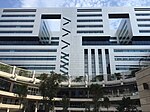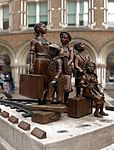Broadgate

Broadgate is a large, 32-acre (13 ha) office and retail estate in the Bishopsgate Without area of the City of London. It is owned by British Land and GIC and managed by Savills.The estate is in part of the eastern City fringe, outside the line of the now lost defensive walls, and east of the former Moorfields; a part of the city that is often described as part of the East End of London. The original developer was Rosehaugh: it was built by a Bovis / Tarmac Construction joint venture and was the largest office development in London until the arrival of Canary Wharf in the early 1990s. The original scheme was designed by Arup Associates, Team 2, which was headed by Peter Foggo, who later left Arup to set up his own practice Peter Foggo Associates, where he completed the initial phase of works. Broadgate Circle is a civic space at the heart of the Broadgate Estate. The Circle was part of the original design by Arup Associates and was redesigned by the group, now called Arup Architecture, in 2015. The key colonnade structure, formed of 54 travertine columns, was maintained and the retail spaces and amphitheatre were modernised and made more accessible. Throughout the year the space is used for a wide range of activities.
Excerpt from the Wikipedia article Broadgate (License: CC BY-SA 3.0, Authors, Images).Broadgate
Broadgate Circle, City of London
Geographical coordinates (GPS) Address Nearby Places Show on map
Geographical coordinates (GPS)
| Latitude | Longitude |
|---|---|
| N 51.519 ° | E -0.0835 ° |
Address
Broadgate Circle Arena
Broadgate Circle
EC2M 2QS City of London
England, United Kingdom
Open on Google Maps










